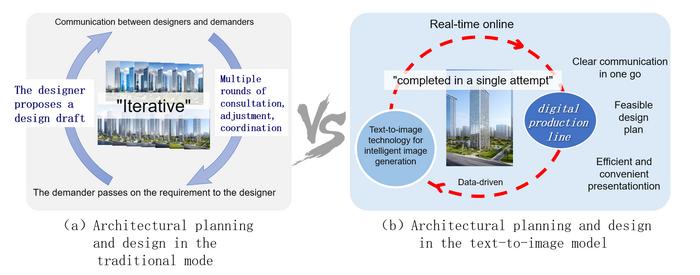
In recent advancements, the synergy between artificial intelligence and urban planning has reached new heights, propelled by the emergence of text-to-image technology. The latest research led by Academician Zhang Xinchang and his team at Guangzhou University emphasizes the transformative potential of this innovative technology within the realms of urban and rural planning. The study meticulously assesses the current hurdles in the adaptation of text-to-image solutions to architectural design, identifying solutions that may redefine conventional practices.
Text-to-image technology, rooted in sophisticated machine learning frameworks, allows for the generation of visual content from textual descriptions. This technological paradigm shift promises a streamlined communicative process between stakeholders in architectural design, including clients and architects. The traditional model of architectural planning often necessitates extensive dialogues and iterative feedback loops, leading to prolonged timelines and potentially misaligned expectations. However, incorporating text-to-image methodologies enables real-time replies, reducing barriers to clear conceptual transmission.
The study proposes an innovative approach to bolster the efficacy of text-to-image applications in urban planning, particularly addressing the issue of inadequate data for model training. By implementing a data augmentation strategy tailored specifically for urban and rural contexts, the researchers suggest that the models can better adapt to the unique requirements and challenges posed by various scenarios. This precision-oriented data enhancement can substantially improve the reliability of generative outputs, ensuring that resulting images accurately represent intended designs.
One of the pivotal findings is the necessity for incorporating spatial information into the generative models. Zhan’s research posits that developing larger models with augmented spatial awareness—utilizing expanded instructions—can significantly enhance the understanding of spatial configurations. Such spatially aware frameworks are crucial, as they can dictate how generated visual designs correspond with the actual geography of a site. This methodology promises that architectural outputs not only reflect artistic intentions but also practical spatial realities.
Moreover, the analysis identifies the importance of localized editing capabilities within text-to-image systems. As urban planning increasingly demands precision and the ability to adjust designs dynamically, the researchers highlight the potential of creating a local editing large model specifically for text-to-image generation. This model could provide architects the ability to modify layouts and designs responsively, ensuring that each unique project maintains fidelity to its specific requirements without sacrificing speed.
The experimental results gathered from the research reaffirm the profound applicability of text-to-image technology across various urban planning sectors. Tasks such as revitalizing aged housing complexes, strategizing industrial zone designs, and executing targeted rural redevelopment initiatives stand to benefit immensely. The essence of interactivity, time efficiency, and professional standards fostered through this technology could serve as a catalyst for innovative evolutions in both urban and rural planning methodologies.
Additionally, with the rapid evolution of generative artificial intelligence, the advantages offered by text-to-image technology cannot be overstated. These systems are not only optimizing the design processes but are also enhancing the efficiency of visual content creation. Complex scene modeling, which traditionally has been painstaking and resource-intensive, can now be navigated swiftly, offering planners an agile and flexible approach to realizing their visions.
However, despite these promising developments, the researchers candidly acknowledge that the current landscape of text-to-image technology remains in an exploratory phase. The domain grapples with challenges, notably the scarcity of comprehensive datasets, the underutilization of domain-specific knowledge, and the inherent difficulties in governing the generated content. Addressing these issues is paramount for the continued advancement of the technology and its integration into professional practice.
As the field of urban planning continually evolves, the integration of text-to-image technology stands to radically reshape established design paradigms. By breaking down existing technological barriers and expanding the capabilities of generative models, the prospects for creativity and practicality will be broadened. This evolution will inevitably lead to enhanced planning applications, thereby elevating the level of intellectual engagement within the field.
In conclusion, the advancements in text-to-image technology herald a new chapter in urban and rural planning, one that embraces the intersection of innovation and practical application. As architects and planners harness the capabilities of these systems, the future of urban landscapes promises to be as imaginative as it is scientifically grounded. This intricate relationship between AI technologies and architectural practice not only enhances existing frameworks but also redefines the processes that govern how we envision and actualize our built environments.
Subject of Research: The application of text-to-image technology in urban and rural planning design.
Article Title: Research and Application of Wensheng Graph Technology Based on AI Big Model.
News Publication Date: 25-Jan-2025.
Web References: DOI Link
References: Not specified in the content.
Image Credits: Credit: Beijing Zhongke Journal Publishing Co. Ltd.
Keywords
text-to-image technology, urban planning, architectural design, artificial intelligence, spatial awareness, data augmentation, generative models, local editing, innovative practices, GIS technology.
Tags: AI-driven architectural design solutionsdata augmentation strategies for urban contextseffective communication in architectural designenhancing stakeholder communication in designfuture of technology in urban and rural developmentinnovations in rural planning methodologiesmachine learning applications in architectureovercoming challenges in text-to-image adaptationreal-time feedback in architectural projectsredefining conventional urban design practicestext-to-image technology in urban planningtransformative impacts of AI on city planning





